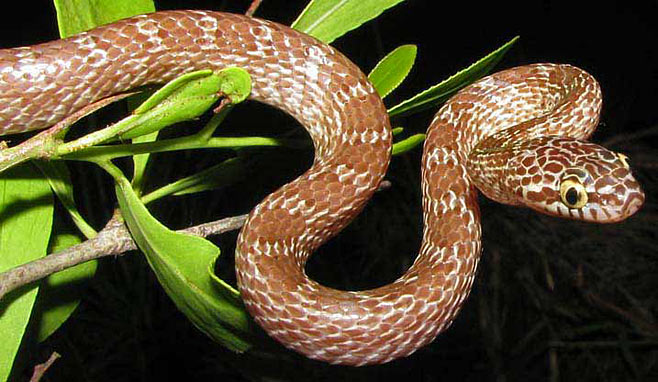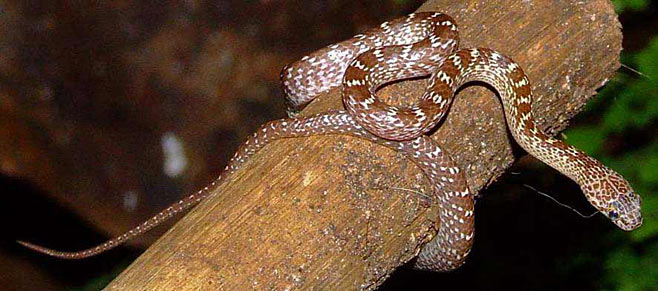|
Dipsadoboa aulica (Marbled tree snake)
Marmerslang [Afrikaans]
Life >
Eukaryotes
>
Opisthokonta >
Metazoa
(animals) > Bilateria > Deuterostomia >
Chordata >
Craniata > Vertebrata (vertebrates) > Gnathostomata (jawed vertebrates) >
Teleostomi (teleost fish) > Osteichthyes (bony fish) > Class:
Sarcopterygii (lobe-finned fish) > Stegocephalia (terrestrial vertebrates) >
Tetrapoda
(four-legged vertebrates) > Reptiliomorpha > Amniota >
Reptilia (reptiles) >
Romeriida > Diapsida > Lepidosauromorpha > Lepidosauria >
Squamata > Serpentes
(snakes) > Family: Colubridae > Subfamily:
Colubrinae > Genus:
Dipsadoboa
 |
|
Dipsadoboa aulica (Marbled tree snake),
Mpumalanga, South Africa. [M. Douglas ©, from
SARCA Virtual Museum] |
 |
|
Dipsadoboa aulica (Marbled tree snake),
Mpumalanga, South Africa. [I.C. Sharp and A. Sharp ©, from
SARCA Virtual Museum] |
Identification
The Marbled tree snake can be identified by its large eyes
(with vertical pupils),
a head which is distinct from its body, a white tongue and its nocturnal
lifestyle. It grows to an average length of 60 cm and a maximum length of 85 cm.
Distribution and habitat
Found in KwaZulu-Natal, Limpopo, Swaziland,
southeast Zimbabwe and southern and central Mozambique. Its favoured habitats are
lowland forest and moist savanna.
Food
Eats lizards (particularly geckos),
frogs,
toads and small
rodents.
Predators, parasites and disease
Eaten by other snakes.
Reproduction
Oviparous (egg-laying), lays between 7and 9 eggs in summer.
Longevity
Has been known to live for between 10 and 15 years.
Medical importance
Although venomous is not thought to be dangerous to man.
Links
References
-
Broadley, D.G. 1983. FitzSimons' Snakes of Southern
Africa. Delta Books, Johannesburg.
-
Marais, J. 2004. A Complete Guide to Snakes of
Southern Africa. Struik Publishing, Cape Town.
|
